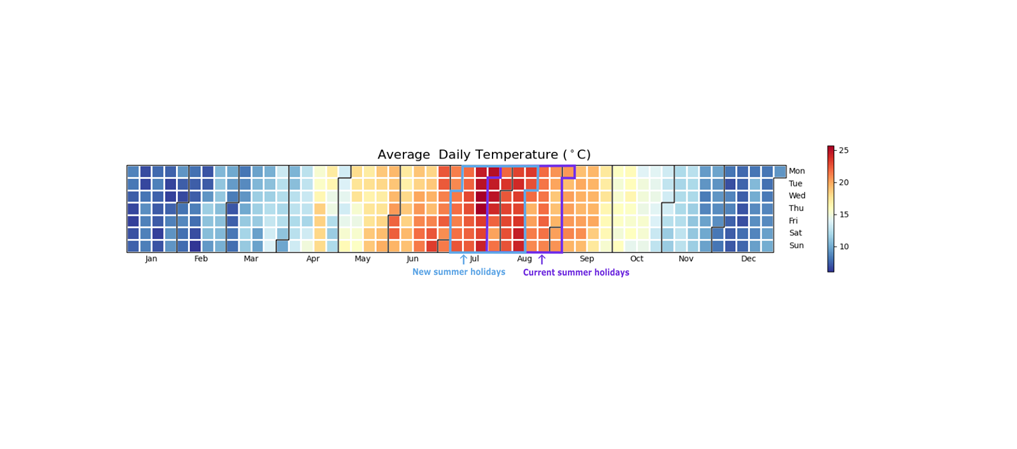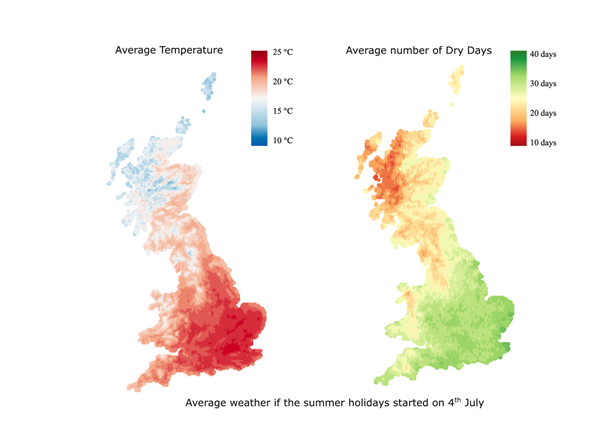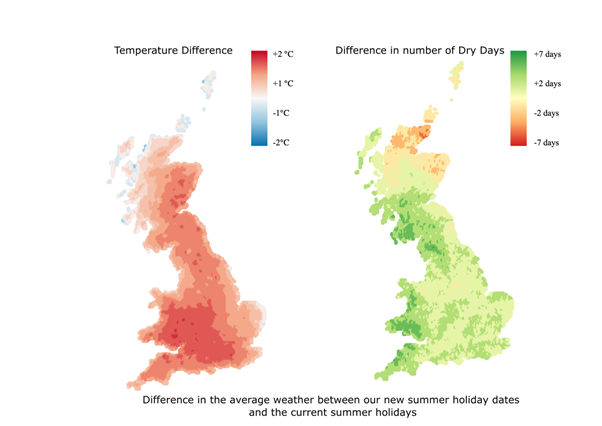When should the summer holidays be?

We all expect the back to school routine to be accompanied by wet gloomy walks to school in the rain. However this year after a wet August, our cold autumn mornings were replaced by what feels like an unexpected heatwave.
We experienced the longest run of September days over 30C on record, and reached a maximum temperature of 32.7C on Saturday 9th September – the hottest day of the year.
This got us thinking – are the school summer holidays starting at the right time? To find out we decided to investigate the weather conditions over the summer for the past 5 years.
Investigating the summer weather conditions
In the summer holidays we want to be able to spend time outside, whether in the garden, out on walks or visiting local attractions. To enjoy our days out we need nice weather! So we want to find which 6 week period over the summer is the warmest and has the most dry days on average.
To ensure the weather conditions aligned with where children and their families live, we used school locations across the UK as reference points. We averaged weather conditions across all schools to pinpoint the best six-week period for most children.
Data
For a daily record of temperature and rainfall, we used the Met Office Had-UK grid. We downloaded the daily maximum air temperature and daily precipitation records on a 5km grid covering the UK for the past 5 years (2018 – 2022). Then to find the location of schools we used our own OS AddressBase.
Method
To find the average summer weather conditions across British schools we uploaded the Had-UK and OS Addressbase data to a SQL Postgres database. We then matched each school to the 5km grid square which it falls within to provide a daily record of temperature and rainfall at each school.
The Met Office defines a ‘rain day’ as a day with greater than 1mm of rainfall. For each possible start date we counted the number of days with less than 1mm of precipitation over the following 6 weeks to create a total number of dry days at each school location.
Next, to find the hottest possible 6 weeks we used the temperature data to create a 6 week rolling average for each possible start date of the school holidays.
We then averaged these results across all the schools in Britain and over the past 5 years, and ranked each 6 week period on its average temperature and the number of dry days it contains. Then we could create a combined ranking to find out when the summer holidays should start for a balance between warm and dry weather.
What is the weather like in the current school holidays?
Before we discussed the best possible school holiday period, we wanted to know what the weather is like in the current school holidays. The exact dates of the school holidays can vary by school and region but typically begin around 24th July in England.
In the 6 weeks following the 24th July the average temperature at schools across Britain is 22.0C with 28 ‘dry days’. There is some variation across the UK, for example in the south east the average temperature is 23.8C with over 30 dry days, whereas in northern Scotland the average temperature get as low as 12C with under 15 dry days.

When looking at this new start date a bit more closely, the most significant temperature improvement is seen across the Midlands and Wales, and the greatest improvement in number of dry days is seen across the west of the country, including popular summer holiday destinations like Devon and the Lake District.
On the other hand we don’t see much of an improvement in Scotland, with some areas appearing colder and wetter.

However we realised that in Scotland the school holiday period is already earlier, typically starting in late June or early July and finishing in mid August. This means that Scottish schools are already taking advantage of the best weather conditions, and perhaps English schools should follow their example.
When viewed on a calendar, these weather conditions make it pretty clear that we might want to change the usual school holiday schedule:

While such a change would require a lot of thought and planning it could make the summer holidays more enjoyable for students and parents alike.
Finding the right moment to kick off the school holidays is like trying to predict which flavour of ice cream will be the summer favourite – it’s a tough decision, but you know you’ll enjoy it no matter what! So let’s embrace the unpredictability of British weather and remember that every day can be a good day for ice cream.
